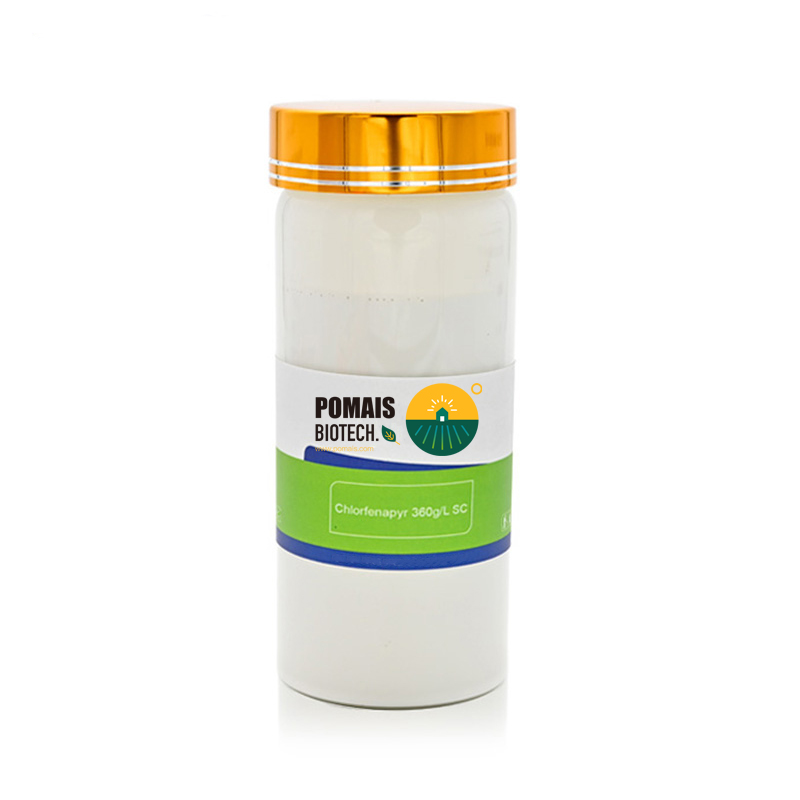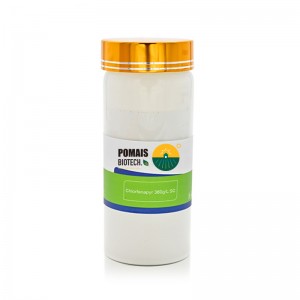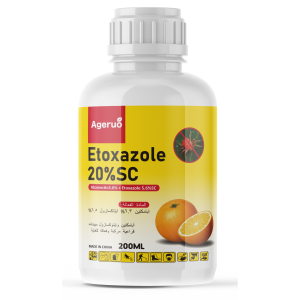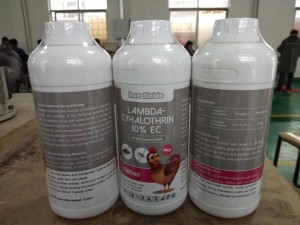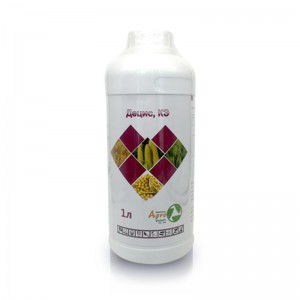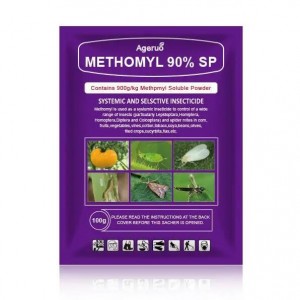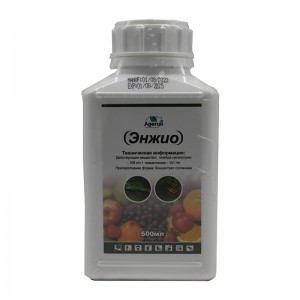Products
POMAIS Chlorfenapyr Insecticide 36%SC
What is Chlorfenapyr?
Chlorfenapyr is a newly developed active ingredient belonging to the pyrrole group of compounds. It is derived from microorganisms and has a unique insecticidal effect.Chlorfenapyr has a wide range of applications in agriculture and public health, and is particularly effective in the control of resistant pests.
Application of Chlorfenapyr in Termite Control
In termite control, Chlorfenapyr is applied by spraying or coating to termite activity areas. Its potent insecticidal effect and long-lasting efficacy make it an excellent performer in termite control, effectively protecting buildings and other structures from termite infestation.
Chlorfenapyr in Crop Protection Applications
In agriculture, Chlorfenapyr is used to control a wide range of pests, including mites, leafhoppers, leaf miner flies and more. Depending on the crop and the type of pest, Chlorfenapyr is used in different ways and at different dosages. Farmers need to apply Chlorfenapyr scientifically, depending on the situation, to achieve optimal control.
Application of Chlorfenapyr in the control of disease-transmitting mosquitos
Chlorfenapyr plays an important role in the control of disease-transmitting mosquitoes. By spraying Chlorfenapyr, mosquito populations can be effectively reduced and the risk of disease transmission reduced. Its successful application in many parts of the world proves its importance in public health control.
Mode of action:
Chlorfenapyr is an insecticide precursor, which itself has no toxic effect on insects. After insects feed or contact with chlorfenapyr, in the insect body, chlorfenapyr is converted into an insecticidal active compound under the action of multifunctional oxidase, and its target is the mitochondria in insect somatic cells. Cells will die due to lack of energy, after spraying the pest becomes weaker, spots appear on the body, color changes, activity ceases, coma, limp, and eventually death.
Features and advantages of products:
(1) Chlorfenapyrl is a broad-spectrum insecticide. It has excellent effect on controlling of more than 70 kinds of pests in Lepidoptera, Homoptera, Coleoptera and other orders, especially for diamondback moth and sugar beet in vegetables.
(2) Chlorfenapyr is a biomimetic pesticide with low toxicity and fast insecticidal speed. It can kill pests within 1 hour after spraying, and the effect can reach 85% within one day.
(3) It has a long-lasting effect.after spraying the Chlorfenapyr can control pests in period of 15-20 days, and for the spider mite the period can be as long as 35 days.
(4) Chlorfenapyr has strong penetration.When spraying on the leaves, the active ingredients can penetrate to the back of the leaves, killing insects more thoroughly.
(5) Chlorfenapyr is friendly to the environment.Chlorfenapyr is very safe to humans and livestock. Especially suitable for products with high economic value
(6) Save money.The price of Chlorfenapyr is not cheap,but it has broader insecticidal spectrum,perfect performance on killing pests and long-lasting effect,so the composite cost is lower than most products.
Chlorfenapyr and Resistance
The issue of resistance has always been a challenge in pesticide use. Many pests have developed resistance to conventional insecticides, and Chlorfenapyr's unique mechanism of action gives it a significant advantage in controlling resistant pests. Studies have shown that Chlorfenapyr is effective against a wide range of pests that have developed resistance, providing a new solution for agricultural production and public health.
Environmental impact of Chlorfenapyr
The use of any pesticide may have an impact on the environment, and while Chlorfenapyr is highly effective in killing pests, attention needs to be paid to its potential impact on the environment. When using Chlorfenapyr, environmental regulations should be followed and protective measures should be taken to minimize its impact on non-target organisms and the ecosystem.
Safety of Chlorfenapyr
Chlorfenapyr has been extensively studied for its safety in humans and animals. The results indicate that the use of Chlorfenapyr within the recommended dosage range poses a low health risk to humans and animals. However, it is still important to follow safe use guidelines to avoid overdose and improper handling.
Market Outlook for Chlorfenapyr
The market outlook for Chlorfenapyr is promising with the increase in global agricultural and public health needs. Its highly effective insecticidal effect and superiority against resistant pests make it highly competitive in the market. In the future, Chlorfenapyr is expected to be applied and promoted in more fields.
| Formulations | Crop names |
Fungal diseases |
Dosage |
Usage method |
| 240g/LSC | Cabbage |
Plutella xylostella |
375-495ml/ha |
Spray |
| Green onions |
Thrips |
225-300ml/ha |
Spray |
|
| Tea tree |
Tea green leafhopper |
315-375ml/ha |
Spray |
|
| 10%ME | Cabbage |
Beet Armyworm |
675-750ml/ha |
Spray |
| 10%SC | Cabbage |
Plutella xylostella |
600-900ml/ha |
Spray |
| Cabbage |
Plutella xylostella |
675-900ml/ha |
Spray |
|
| Cabbage |
Beet Armyworm |
495-1005ml/ha |
Spray |
|
| Ginger |
Beet Armyworm |
540-720ml/ha |
Spray |
(1) Cotton: Chlorfenapyr is suitable for controlling bollworms, pink bollworms, and other caterpillar pests infesting cotton.
(2) Vegetables: Effective against aphids, whiteflies, thrips, and various caterpillar pests in vegetable crops such as tomatoes, peppers, cucurbits (e.g., cucumbers, squash), and leafy greens.
(3) Fruits: Used to control insect pests in fruit crops like citrus fruits, grapes, apples, and berries. Some of the pests include fruit flies, codling moths, and mites.
(4) Nuts: Effective against pests like navel orangeworm and codling moth in nut crops such as almonds and walnuts.
(5) Soybeans: Used to control caterpillar pests like soybean looper and velvetbean caterpillar in soybean crops.
(6) Corn: Chlorfenapyr is suitable for controlling corn earworm and fall armyworm pests in corn crops.
(7) Tea: Effective against tea pests such as tea loopers, tea tortrix, and tea leafhoppers.
(8) Tobacco: Used to control tobacco budworm and hornworm pests in tobacco crops.
(9) Rice: Effective against rice leaffolder and stem borers in rice paddies.
(10) Ornamental plants: Chlorfenapyr can be used to control pests in ornamental plants, including caterpillars, aphids, and thrips.
(1) Chlorfenapyr has the characteristics of long-lasting control of pests. To achieve the best effect, you’d better use it during the hatching period of eggs or in the early development of young larvae.
(2) . Chlorfenapyr has the action of stomach poison and touch killing. The drug should be sprayed evenly on the feeding parts of leaf or insect bodies.
(3) Better not use the Chlorfenapyr and other insecticides at the same time.It is better to alternately use the insecticides with different modes of action.No more than 2 times per crop in one season.
(4) Applying the medicine in the evening will get better effect.

